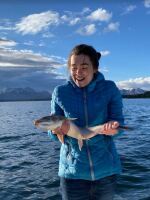Peter Pan Seafoods on Wednesday announced a base price of $1.00 per pound of Bristol Bay sockeye for the 2022 season.
Peter Pan is the first processor to announce its base price this season, following a precedent it set last year, when it became the first company in decades to tell fishermen what they would get paid before the season started.
Peter Pan’s Bristol Bay manager, Travis Roenfanz, said the company wanted to let fishermen know the minimum price for their fish before they get out on the water.
“We did that out of respect for our partners, the fishermen. And just like in 2021, this is a starting point for us,” he said. “We want to evaluate the fishery as it goes along and we'll make adjustments to that price as the season progresses.”
This year’s $1.00 base price is just under the average of $1.04 for the past 12 years and it is lower than 2021, when Peter Pan set the initial price at $1.10 and then bumped it up to $1.25 in July. Roenfanz said the company knew this year’s base wouldn’t be that popular. But officials still wanted to announce the price early. Before last year, fishermen generally didn’t know the minimum payment for their fish until well into the season.
“We wanted the fishermen to have security that it's not going to be less than a dollar. We anticipate seeing it ratchet up. And so we're calling it an initial base price,” Roenfanz said.
Bristol Bay is forecast to see over 70 million sockeye salmon return to the bay this season, with an estimated 60 million fish available to harvest. That’s about double the long-term average, and it's more than 40% above average for the last decade.
Mat Serf, a set netter in the Nushagak district who fishes for Peter Pan, said the $1.00 base is a bit deflating. Still, he hopes the company will raise the price this season.
“In current economic conditions, processors are getting pinched by labor costs and the whole cost of operations right now,” he said. “They could be passing the buck there to fishermen and leaving them holding the bag, but I am hopeful that a dollar isn't where it lands. And that it can at least keep pace with the increased cost of living that everyone's facing this year.”
Inflation rates are at 40-year highs, and like many others, fishermen are dealing with skyrocketing costs of essential products such as food and gas. The Labor Department reports that consumer prices in May were 8.6% higher than the previous year.
Another fisherman on Serf’s crew, Jerik Lee, is heading into his second season fishing in the bay. He said that he'd like more insight into how processors determine prices.
“I've still yet to hear a really clear explanation as to how they set their prices,” he said. “Seemingly it leaves fishermen in our silos, kind of rationalizing why a price might be set. And it seems just more transparency from the processor would help put us at ease in terms of what the price is.”
Higher costs and supply chain issues factored into this year's lower base, Roenfanz said.
“You're definitely seeing an increase in transportation of employees in and out of the region. We're seeing increases in our freight, in our fuel. It's across the board. Everything seems to be higher than what we're anticipating for sure,” he said. “A really big issue that we're faced with is just getting supplies with the shortages that are out there. It's challenging just to get the things that you need to operate.”
Roenfanz said increasing the price will depend on things like the run timing, how many fish return and how big they are.
“I think you could see things as early as a few days, or it could take a couple of weeks to see those things ratchet up,” he said.
Bristol Bay processors generally pay the same base price for sockeye, though bonuses vary. So far, no other companies have announced what they will pay their fleet this season.
Contact the author at izzy@kdlg.org or 907-842-2200.




